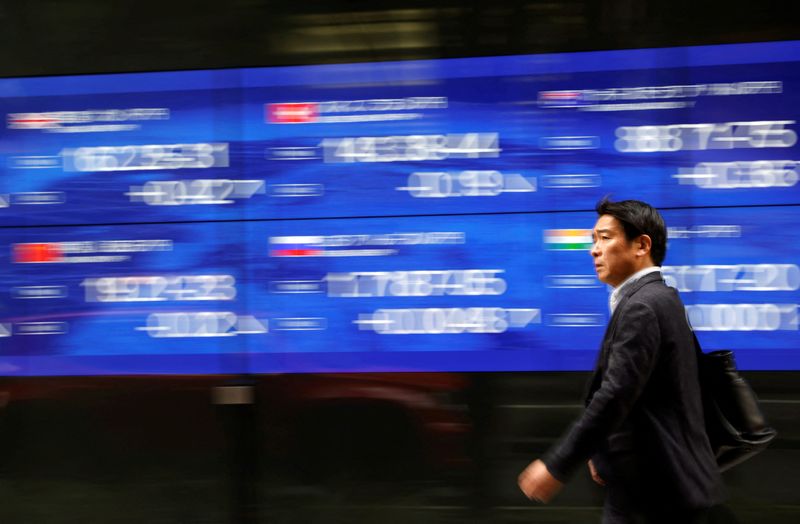By Herbert Lash
NEW YORK (Reuters) -Stocks in Europe and on Wall Street fell on Tuesday, along with prices for U.S. government debt, on ebbing market optimism about timely interest rate cuts from the Federal Reserve.
The dollar jumped against major currencies as the yield on the 10-year Treasury note, which moves inversely to price, rebounded to trade above 4% early in the day - sign of lowered expectations for rate cuts in 2024.
The U.S. benchmark's yield last week traded as low as 3.783%, or more than the 150 basis points of rate cuts that futures have priced in by next December for the Fed's target interest rate as the economy slows.
The biggest concern is whether the market misinterprets slowing growth as a warning sign for a looming recession, said Jack Janasiewicz, portfolio manager and lead portfolio strategist at Natixis Investment Managers Solutions in Boston.
"The risk is that we get a couple of soft prints (but) the one that matters the most is going be the labor market," he said. "My gut says that the market will extrapolate weakness into that hard landing outcome. That's probably going to be somewhat of a misleading backdrop."Technology shares led stock market declines on both sides of the Atlantic. The Atlanta Fed lowered its GDPNow estimate for seasonally adjusted annualized growth in the fourth quarter of 2023 to 2.0% from its Dec. 22 estimate of 2.3%.
U.S. construction spending in November rose less than expected but data for the prior month was revised sharply higher, suggesting underlying strength.
The dollar strengthened because its recent sell-off was overdone, said Marc Chandler, chief market strategist at Bannockburn Global Forex in New York. The jobs report for December Friday will likely show a still robust U.S. labor market, he said.
"When the Fed meets later this month they're going to see above-trend growth and a resilient labor market. A resilient labor market means income, which means demand, that's why the dollar is recovering," Chandler said.
A Reuters poll shows economists expect 168,000 jobs were created last month, down from 199,000 in November, and the unemployment rate will tick up to 3.8% from 3.7%.
The dollar index, a measure of the U.S. currency against six major trading partners, rose 0.83% and was on track for its biggest daily percentage gain since October.
The euro fell 0.91% to $1.0943 and the Japanese yen weakened 0.77% at 141.95 per dollar.
In Europe, the pan-regional STOXX 600 index closed down 0.11%, while MSCI's U.S.-centric gauge of stocks across the globe shed 1.01%.
On Wall Street, the Dow Jones Industrial Average rose 0.07%, the S&P 500 lost 0.57% and the Nasdaq Composite dropped 1.63%.
Last Friday, the three major U.S. stock indexes notched monthly, quarterly and annual gains as traders priced in a higher probability of Fed rate cuts this year. The benchmark S&P 500 closed the year within 1% of a record closing high set on Jan. 3, 2022.
Futures show traders expect about a 79% chance of a 25 basis point cut or more in the Fed's overnight rate when policymakers meet in March, according to the CME Group's (NASDAQ:CME) FedWatch Tool. Traders see the Fed's target rate at 3.831% in December.
The yield on the 10-year Treasury note rose 7.3 basis points to 3.933%.
Euro zone government bond yields rose, with the benchmark 10-year German yield up 0.4 basis points on the day at 2.068%.
Traders are gauging whether major central banks will judge inflation has slowed enough to allow for deep rate cuts to bolster the economy.
Oil prices fell as investors tempered the outlook for rate cuts and on easing concerns that tensions in the Red Sea (NYSE:SE) will disrupt supplies. Prices had climbed around $2 a barrel earlier following attacks on vessels by Houthi rebels over the weekend and the reported arrival of an Iranian warship on Monday.
U.S. crude settled down $1.27 to $70.38 a barrel, while Brent fell $1.15 to settle at $75.89 a barrel.
Separately, the head of energy firm E.ON said Mideast instability could send energy prices soaring, but that Germany's gas supply is in far better shape than it was after Russia cut off supplies last winter.

Data pointing to subdued business confidence in China for 2024 weighed on Chinese assets during Asian trading. China's onshore blue chip index was down 1.3% and Hong Kong's Hang Seng index fell 1.5.
Spot gold dropped 0.2% to $2,058.59 an ounce.
